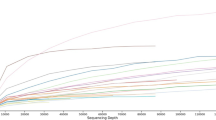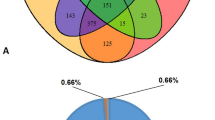Abstract
The next generation sequencing (NGS) approach has facilitated the investigations of gut microbiota with high throughput and resolution. The present study was focused on the taxonomic and functional characterization of bacterial community associated with different developmental stages of melon fly, Zeugodacus cucurbitae using 16S ribosomal RNA (rRNA) gene amplicons metagenomics. Z. cucurbitae is considered an invasive and most staid polyphagous pest of cucurbitaceous and other related crops. The taxonomic analysis of highly variable V3–V4 region of bacterial 16S rRNA gene sequencing indicated that the bacterial community associated with Z. cucurbitae consists of a total of 23 bacterial phyla (including unclassified and unassigned bacteria), comprising 32 classes, 69 orders, 99 families and 130 genera. Proteobacteria, Firmicutes, Actinobacteria and Tenericutes were dominant phyla of which family, Enterobacteriaceae was the most abundant in the larval and adult female stages, whereas Mycoplasmataceae was the dominant in the pupal stage. In larval stages of Z. cucurbitae, genus Providencia and Comamonas were the most abundant. However, genus Candidatus-Bacilloplasma and Klebsiella were the most dominant in pupae and adult females of Z. cucurbitae, respectively. PICRUSt analysis conducted for prediction of metabolic activities revealed that associated microbiota were involved in membrane transport, carbohydrate metabolism, amino acid metabolism, energy metabolism, replication and repair processes as well as cellular processes and signalling. The higher number of OTUs was annotated for phosphoglycerate mutase and transketolase in adult females followed by larval stages, which may support the digestive function of the microbiota in larvae and adult females. Our findings provide insights about the high variation in microbiota across developmental stages and basis for microbiota-based management strategies of fruit flies.





Similar content being viewed by others
Data Availability
Final sequence read achieves (SRAs) were deposited in the NCBI SRA database under the Bioproject accession ID PRJNA587221.
References
Drew RAI, Hancock DL (2000) Phylogeny of the Tribe Dacini (Dacinae) based on morphological, distributional, and biological data. In: Aluja M, Norrbom AL (eds) Fruit flies (Tephritidae): phylogeny and evolution of behavior. CRC Press, Boca Raton, pp 491–504
Douglas AE (2015) Multiorganismal insects: diversity and function of resident microorganisms. Annu Rev Entomol 60:17–34
Dillon R, Dillon V (2004) The gut bacteria of insects: non pathogenic interactions. Annu Rev Entomol 49:71–79
Engel P, Moran NA (2013) The gut microbiota of insects-diversity in structure and function. FEMS Microbiol Rev 37:699–735. https://doi.org/10.1111/1574-6976.12025
Hammer TJ, Bowers MD (2015) Gut microbes may facilitate insect herbivory of chemically defended plants. Oecologia 179:1–14. https://doi.org/10.1007/s00442-015-3327-1
Wingfield MJ, Garnas JR, Hajek A, Hurley BP, Wilhelm de Beer Z, Taerum SJ (2016) Novel and co-evolved associations between insects and microorganisms as drivers of forest pestilence. Biol Invas 18:1045–1056
Malacrinò A, Campolo O, Medina RF, Palmeri V (2018) Instar- and host-associated differentiation of bacterial communities in the Mediterranean fruit fly Ceratitis capitata. PLoS ONE 13:e0194131
Parmentier L, Meeus I, Mosallanejad H, de Graaf DC, Smagghe G (2016) Plasticity in the gut microbial community and uptake of Enterobacteriaceae (Gammaproteobacteria) in Bombusterrestris bumblebees’ nests when reared indoors and moved to an outdoor environment. Apidologie 47:237–250. https://doi.org/10.1007/s13592-015-0393-7
Zhao X, Zhang X, Chen Z, Wang Z, Lu Y, Cheng D (2018) The divergence in bacterial components associated with Bactrocera dorsalis across developmental stages. Front Microbiol 9:114. https://doi.org/10.3389/fmicb.2018.00114
Wang A, Yao Z, Zheng W, Zhang H (2014) Bacterial communities in the gut and reproductive organs of Bactrocera minax (Diptera: Tephritidae) based on 454 pyrosequencing. PLoS ONE 9:e106988
Aharon Y, Pasternak Z, Ben Yosef M, Behar A, Lauzon C, Yuval B, Jurkevitch E (2013) Phylogenetic, metabolic, and taxonomic diversities shape Mediterranean fruit fly microbiotas during ontogeny. Appl Environ Microbiol 79:303–313. https://doi.org/10.1128/AEM.02761-12
Yun JH, Roh SW, Whon TW, Jung M-J, Kim M-S, Park D-S, Yoon C, Nam Y-D, Kim Y-J, Choi J-H, Kim J-Y, Shin N-R, Kim S-H, Lee W-J, Bae J-W (2014) Insect gut baterial diversity determined by environmental habitat, diet, develeopmental stage, and phylogeny of host. Appl Environ Microbiol 80:5254–5264
Kaczmarczyk A, Kucharczyk H, Kucharczyk M, Kapusta P, Sell J, Zielińska S (2018) First insight into microbiome profile of fungivorous thrips Hoplothripscarpathicus (Insecta: Thysanoptera) at different developmental stages: molecular evidence of Wolbachia endosymbiosis. Sci Rep. 8(1):14376. https://doi.org/10.1038/s41598-018-32747-x
Zabalou S, Riegler M, Theodorakopoulou M, Stauffer C, Savakis C, Bourtzis K (2004) Wolbachia-induced cytoplasmic incompatibility as a means for insect pest population control. Proc Nat Acad Sci USA 101:15042–15045. https://doi.org/10.1073/pnas.0403853101
Naaz N, Choudhary JS, Prabhakar CS, Moanaro MS (2016) Identification and evaluation of cultivable gut bacteria associated with peach fruit fly, Bactrocera zonata (Diptera: Tephritidae). Phytoparasitica 44:165–176
Hadapad AB, Prabhakar CS, Chandekar SC, Tripathi J, Hire RS (2016) Diversity of bacterial communities in the midgut of Bactrocera cucurbitae (Diptera: Tephritidae) populations and their potential use as attractants. Pest Manag Sci 72:1222–1230
Gujjar NR, Govindan S, Verghese A, Subramaniam S, More R (2017) Diversity of the cultivable gut bacterial communities associated with the fruit flies Bactrocera dorsalis and Bactrocera cucurbitae (Diptera: Tephritidae). Phytoparasitica 45:453–460
Yong HS, Song SL, Eamsobhana P, Pasartvit A, Lim PE (2019) Differential abundance and core members of the bacterial community associated with wild male Zeugodacus cucurbitae fruit flies (Insecta: Tephritidae) from three geographical regions of Southeast Asia. Mol Biol Rep 46:3765–3776. https://doi.org/10.1007/s11033-019-04818-3
Hadapad AB, Shettigar SKG, Hire RS (2019) Bacterial communities in the gut of wild and mass-reared Zeugodacus cucurbitae and Bactrocera dorsalis revealed by metagenomic sequencing. BMC Microbiol 19(Suppl 1):282
Noman S, Shi G, Liu L, Li Z (2020) Diversity of bacteria in different life stages and their impact on the development and reproduction of Zeugodacus tau (Diptera: Tephritidae). Insect Sci. https://doi.org/10.1111/1744-7917.12768
Abdelfattah A, Malacrinò A, Wisniewski M, Cacciola SO, Schena L (2017) Metabarcoding: a powerful tool to investigate microbial communities and shape future plant protection strategies. Biol Control 120:1–10. https://doi.org/10.1016/j.biocontrol.2017.07.009
Andrews S (2010) FastQC: a quality control tool for high throughput sequence data. http://www.bioinformatics.babraham.ac.uk/projects/fastqc
Caporaso JG, Kuczynski J, Stombaugh J, Bittinger K, Bushman FD, Costello EK, Fierer N, Peña AN, Goodrich JK, Gordon JI, Huttley GA, Kelley ST, Knights D, Koenig JE, Ley RE, Lozupone CA, McDonald D, Muegge BD, Pirrung M, Reeder J, Sevinsky JR, Turnbaugh PR, Walters WR, Widmann J, Yatsunenko T, Zaneveld J, Knight R (2010) QIIME allows analysis of high- throughput community sequencing data. Nat Methods 7:335–336. https://doi.org/10.1038/nmeth.f.303
Magoč T, Salzberg SL (2011) FLASH: fast length adjustment of short reads to improve genome assemblies. Bioinformatics 27:2957–2963. https://doi.org/10.1093/bioinformatics/btr507
Rognes T, Flouri T, Nichols B, Quince C, Mahé F (2016) VSEARCH: a versatile open source tool for metagenomics. Peer J 4:e2584
Edgar RC (2010) Search and clustering orders of magnitude faster than BLAST. Bioinformatics 26:2460–2461
Caporaso JG, Bittinger K, Bushman FD, De Santis TZ, Andersen GL, Knight R (2010) PyNAST: a flexible tool for aligning sequences to a template alignment. Bioinformatics 26:266–267. https://doi.org/10.1093/bioinformatics/btp636
Dhariwal A, Chong J, Habib S, King I, Agellon LB, Xia J (2017) MicrobiomeAnalyst - a web-based tool for comprehensive statistical, visual and meta-analysis of microbiome data. Nucleic Acids Res 45:180–188. https://doi.org/10.1093/nar/gkx295
Hammer Ø, Harper D, Ryan P (2001) PAST: paleontological statistics software package for education and data analysis. Palaeontol Electron 4:9
Langille MGI (2013) Predictive functional profiling of microbial communities using 16S rRNA marker gene sequences HHS Public Access. Nat Biotechnol 31:814–821
Andongma AA, Wan L, Dong Y-C, Li P, Desneux N, White JA, Niu CY (2015) Pyrosequencing reveals a shift in symbiotic bacteria populations across life stages of Bactrocera dorsalis. Sci Rep 5:9470
Liu S, Chen Y, Li W, Tang G, Yang Y, Jiang HB, Dou W, Wang JJ (2018) Diversity of bacterial communities in the intestinal tracts of two geographically distant populations of Bactrocera dorsalis (Diptera: Tephritidae). J Econ Entomol 111(6):2861–2868. https://doi.org/10.1093/jee/toy231
Yong HS, Song SL, Chua KO, Lim PE (2017) High diversity of bacterial communities in developmental stages of Bactrocera carambolae (Insecta: Tephritidae) revealed by Illumina MiSeq sequencing of 16S rRNA gene. Curr Microbiol 74:1076–1082. https://doi.org/10.1007/s00284-017-1287-x
Naaz N, Choudhary JS, Choudhary A, Dutta A, Das B (2020) Developmental stage-associated microbiota profile of the peach fruit fly, Bactrocera zonata (Diptera: Tephritidae) and their functional prediction using 16SrRNA gene metabarcoding sequencing. 3 Biotech 10(9):390. https://doi.org/10.1007/s13205-020-02381-4
Asimakis ED, Khan M, Stathopoulou P, Caceres C, Bourtzis K, Tsiamis G (2019) The effect of diet and radiation on the bacterial symbiome of the melon fly, Zeugodacus cucurbitae (Coquillett). BMC Biotechnol 19(Suppl 2):88
Deutscher AT, Burke CM, Darling AE, Riegler M, Reynolds OL, Chapman TA (2018) Near full-length 16S rRNA gene next-generation sequencing revealed Asaia as a common midgut bacterium of wild and domesticated Queensland fruit fly larvae. Microbiome 6:85
Augustinos AA, Tsiamis G, Cáceres C, Abd-Alla AMM, Bourtzis K (2019) Taxonomy, diet, and developmental stage contribute to the structuring of gut-associated bacterial communities in tephritid pest species. Front Microbiol 10:2004. https://doi.org/10.3389/fmicb.2019.02004
Shi Z, Wang L, Zhang H (2012) Low diversity bacterial community and the trapping activity of metabolites from cultivable bacteria species in the female reproductive system of the oriental fruit fly, Bctrocera dorsalis Hendel (Diptera: Tephritidae). Int J Mol Sci 13:6266–6278
Berasategui A, Shukla S, Salem H, Kaltenpoth M (2016) Potential applications of insect symbionts in biotechnology. Appl Microbiol Biotechnol 100:1567–1577. https://doi.org/10.1007/s00253-015-7186-9
Kostanjsek R, Strus J, Avgustin G (2007) “Candidatus Bacilloplasma”, a novel lineage of mollicutes associated with the hindgut wall of the terrestrial isopod Porcellio scaber (Crustacea: Isopoda). Appl Environ Microbiol 73:5566–5573. https://doi.org/10.1128/AEM.02468-06
Leclercq S, Dittmer J, Bouchon D, Cordaux R (2014) Phylogenomics of “Candidatus Hepatoplasma crinochetorum”, a lineage of mollicutes associated with noninsect arthropods. Genome Biol Evol. https://doi.org/10.1093/gbe/evu020
Capuzzo C, Firrao G, Mazzon L, Squartini A, Girolami V (2005) “Candidatus Erwinia dacicola”, a co-evolved symbiotic bacterium of the olive fly, Bactrocera oleae (Gmelin). Int J Syst Evol Microbiol 55:1641–1647
Andongma AA, Wan L, Dong YC, Desneux N, White JA, Niu CY (2019) Assessment of the Bacteria community structure across life stages of the Chinese Citrus Fly, Bactrocera minax (Diptera: Tephritidae). BMC Microbiol 19:285
Lauzon C, McCombs S, Potter S, Peabody N (2009) Establishment and vertical passage of Enterobacter (Pantoea) agglomerans and Klebsiella pneumoniae through all life stages of the Mediterranean fruit fly (Diptera: Tephritidae). Ann EntomolSoc Am 102:85–95
Prabhakar CS, Sood P, Mehta PK (2008) Protein hydrolyzation and pesticide tolerance by gut bacteria of Bactrocera tau (Walker). Pest Manag Econ Zoo 16:123–129
Kaltenpoth M (2009) Actinobacteria as mutualists: general healthcare for insects. Trends Microbiol 17:529–535. https://doi.org/10.1016/j.tim.2009.09.006
Cheng D, Guo Z, Riegler M, Xi Z, Liang G, Xu Y (2017) Gut symbiont enhances insecticide resistance in a significant pest, the oriental fruit fly Bactrocera dorsalis (Hendel). Microbiome 5:13. https://doi.org/10.1186/s40168-017-0236-z
Ben-Yosef M, Pasternak Z, Jurkevitch E, Yuval B (2014) Symbiotic bacteria enable olive flies (Bactrocera oleae) to exploit intractable sources of nitrogen. J Evol Biol 27:2695–2705
Prabhakar CS, Sood P, Kapoor V, Kanwar S, Mehta P, Sharma P (2009) Molecular and biochemical characterization of three bacterial symbionts of fruit fly, Bactrocera tau (Tephritidae: Diptera). J Gen Appl Microbiol 55:479–487
Kanehisa M (2019) Toward understanding the origin and evolution of cellular organisms. Protein Sci 28:1947–1951
Author information
Authors and Affiliations
Contributions
JSC, NN, BD and BPB designed the study; NN and JSC carried out the experiments; NN, JSC and CSP analysed the data; NN, JSC, CSP, BD, AKS and BPB shared in scoping the study, data interpretation and writing the manuscript. All the authors have read and approved the final manuscript.
Corresponding author
Ethics declarations
Conflict of interest
The authors declare that they have no conflict of interest.
Ethical Approval
The study does not involve endangered or protected species and did not require any permission to conduct the experiment.
Additional information
Publisher's Note
Springer Nature remains neutral with regard to jurisdictional claims in published maps and institutional affiliations.
Supplementary information
Below is the link to the electronic supplementary material.
Rights and permissions
About this article
Cite this article
Choudhary, J.S., Naaz, N., Prabhakar, C.S. et al. High Taxonomic and Functional Diversity of Bacterial Communities Associated with Melon Fly, Zeugodacus cucurbitae (Diptera: Tephritidae). Curr Microbiol 78, 611–623 (2021). https://doi.org/10.1007/s00284-020-02327-2
Received:
Accepted:
Published:
Issue Date:
DOI: https://doi.org/10.1007/s00284-020-02327-2




